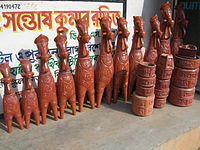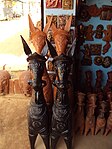Bankura horse
| Bankura horse Bankura Panchmura Terracotta Craft | |
|---|---|
| Geographical indication | |
 Bankura horse | |
| Description | Bankura horse is a terracotta arts of West Bengal |
| Type | arts of West Bengal |
| Area | Panchmura, Bankura, West Bengal |
| Country | |
| Registered | 28 March 2018 |
| Material | Clay |
| Official website | ipindiaservices.gov.in |
Bankura horse is the terracotta horse, produced in Panchmura village in Bankura district in the Indian state of West Bengal. It has been praised for “its elegant stance and unique abstraction of basic values.” Originally used for village rituals, it now adorns drawing rooms across the world as symbols of Indian folk-art.[1] It is the logo of All India Handicrafts.[2]
Tradition[edit]
Terracotta or clay craft has been the symbol of man's first attempt at craftsmanship, just as the potter’s wheel was the first machine invented to use the power of motion for a productive purpose. For many years, civilizations have been dated and assessed by the degree of skill and beauty displayed by the earthenware found in excavations. Because of its universal appeal pottery has often been termed as the lyric of handicrafts. However, its association with religious rituals has imbibed it with deeper significance. In India, terracotta traditions are found from the earliest times. The outskirts of many an Indian village, has a pipal tree with terracotta animal figures lying underneath it. They are symbols of fulfillment of aspirations of village folk. In order to cater to the commercial requirements of the modern global market, the village potter is often combining the traditional rural abstractions with refined urban tastes to show pieces of terracotta art.[1]
The principal centres where the terracotta horses and elephants are produced are Panchmura, Rajagram, Sonamukhi and Hamirpur. Each place has its local style. The Panchmura-style of pottery is considered the best and the finest of all the four types.[3]
Process[edit]
Different parts of the hollow terracotta horses are turned out in separate parts, on the potter’s wheel. The four legs, the full neck in two parts and the face (seven pieces in all) are turned out separately on the wheel and then joined together. Additional clay is used for making up defects that may remain in the shape of the body. The leaf-like ears and the tails are done in moulds and are later inserted in grooves left on the body. The clay figures are then allowed to dry in the sun. After a little drying in the sun, holes are made on appropriate parts of the body in order that the inner and the outer surfaces of the body are equally dried. Cracks may develop in the body because of unequal drying of the inner and the outer portions. The dehydration is slowly done in the normal temperature of a closed room for about six or seven days. Then they are brought out of the room and heated in the sun. Finally they are burnt.[3]
The terracotta horses of Bankura are turned out in two different colours. The normal terracotta red color is obtained by letting out the smoke through the vents of the kiln after firing, and the black colour is obtained by sealing the vents and not letting out the smoke.[3]
Significance[edit]
In the Rarh region where Dharmathakur is worshipped there is no end to the symbolic use of terracotta and wooden horses. Symbolic sacrifice of horses for fulfillment of wishes is common for many village gods and goddesses, but an assembly of terracotta horses of various shapes and sizes representing sacrifice on wish fulfillment is perhaps peculiar to Dharmathakur.[4]
Shape[edit]
Terracotta horses and elephants in Bankura have been the creation of potters. Over the centuries they have moved away from a realistic presentation to a representational presentation. Potter-artists of different regions focused on different parts of the animal body in such a manner that representation of the same became more important than representation of the entire body of the animal.[5]
Geographical Indications[edit]
Bankura horse is registered under the Geographical Indications of West Bengal, named Bankura Panchmura Terracota Craft on 28 March 2018.[6]
See also[edit]
Bankura horse gallery[edit]
References[edit]
- ↑ 1.0 1.1 "Terracotta Traditions". potteryindia. Archived from the original on 2002-07-06. Retrieved 2009-06-22.
- ↑ "Bankura's Horses". bengalinet. Retrieved 2009-06-22.
- ↑ 3.0 3.1 3.2 "Arts". Bankura Pottery. Suni Systems (P) Ltd. Retrieved 2009-06-22.
- ↑ Mitra, Dr. Amalendu, Rarher Sanskriti O Dharmathakur, First published 1972, 2001 edition, pp. 156-159, Subarnarekha, 73 Mahatma Gandhi Road, Kolkata
- ↑ Ghosh, Binoy, Paschim Banger Sanskriti, (in Bengali), part I, 1976 edition, pp. 69-71, Prakash Bhaban
- ↑ "Details | Geographical Indications | Intellectual Property India". ipindiaservices.gov.in. Retrieved 2018-08-05.






